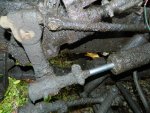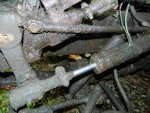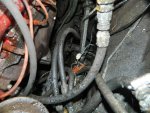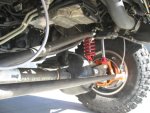Posted this picture in another thread a long time ago, and it's a good example of a fabricated pitman arm with a heimijoint mounted in double-shear. See how it eliminates any kind of bending loads on the hardware.
Much stronger/safer. Tierod-ends can get away with being mounted in single-shear because they have those tapered studs.
Would also not be a bad idea to tie those high-steer arms into the tierod mounting holes in the stock steering arms while you're at it. Those kinpin cap bolts were never designed to see the kind of loads they're subjected to when they have steering arms mounted to them and they have been known to fail.
Was just looking at your pictures again and had not noticed that you're still using the double-ended ram? That's something else that should probably be addressed. See, the double-ended ram with two short end-links is going to fight the straight tierod. They're each trying to swing the tires through slightly different arcs, which causes a bind/deflection, and that's going to be very hard on your heim-joints. Best case scenario is that they wear out prematurely. You've got a couple options though:
1) Remove the straight tierod. You don't need it. The double-ended tierod with those end-links is perfectly capable of serving as the only mechanical link (tierod) between the two front tires. If you ask me, this would be the best/easiest solution. The only downside is that the
Ackermann geometry is going to be slightly better with a straight tierod. When I ws
designing the steering system for mah deuce, I modeled the steering geometry and the effect that mounting the same double-ended PSC ram in different locations would have (closer to the axlehousing = better).
2) re-mount the double-ended ram using a clevis-type mount so that it would actually be mounted like a single-ended ram. This would allow you to preserve the better steering geometry that a straight tierod gives you, and would be better than using an unbalanced single-ended ram (steering force/speed is different when turning left/right). Alternately, you could devise some type of shackle or swinging link that would allow you to use the existing ram mount and attach one end of the ram directly to the straight the straight tierod without causing anything to bind.
If you have any more questions, please don't hesitate to ask. Happy to help. There's also a ton of great tech on all these topics over on Pirate4x4 if you want to do some more research.
View attachment 466001 View attachment 466002







